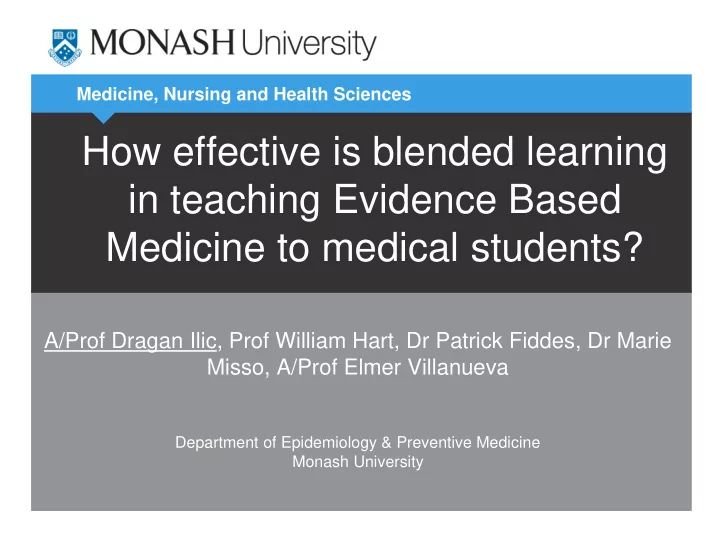

Medicine, Nursing and Health Sciences How effective is blended learning in teaching Evidence Based Medicine to medical students? A/Prof Dragan Ilic, Prof William Hart, Dr Patrick Fiddes, Dr Marie Misso, A/Prof Elmer Villanueva Department of Epidemiology & Preventive Medicine Monash University
Background Teaching evidence based medicine (EBM) is an integral part of the medical curriculum Students competent in EBM have the necessary research skills to identify, appraise and implement research evidence into clinical practice Teaching in EBM provides learners with a variety of quantitative research skills including epidemiology, public health, biostatistics, information literacy 2
Background When teaching we need to account for different learning styles; – Visual, auditory, kinaesthetic, combination Educational modes include; – Lectures, tutorials, seminars, workshops, problem based learning (PBL), simulations 3
Background Where’s the evidence on how to teach EBM? Systematic review – 9 RCTs – Education increases competency! – No difference in learner outcomes across; • Lecture vs online • Direct vs self-directed • Multidisciplinary vs discipline specific groups • Lecture vs active small group facilitated learning Ilic D, Maloney S. Methods of teaching medical trainees Evidence Based Medicine: A systematic review. Medical Education (in press) 4
Aims Is a blended learning approach to teaching EBM more effective than a traditional EBM teaching approach at increasing student competency in EBM? 5
Method A multi-centre controlled trial with second year graduate medical students Intervention: EBM course delivered using a blended learning approach (BL) Comparison: EBM course delivered in a tutorial format (TUTE) 6
Teaching approach BL: TUTE: – One ‘block’ learning – 10 week EBM day on EBM program delivered via – Integrated EBM within lecture/tutorial format clinical rounds – ‘Hot - synching’ – Weekly oral presentation to tutor and peers 7
Assessment Student competency assessed using; – Berlin tool (score 0-15) – A patient-based critical appraisal assessment (%) Student self-perceived confidence and application of EBM skills – Likert scale (1=low, 5=high) Statistical analysis: t-tests Total of 61/71 students (85.9%) completed the outcome assessment 8
Assessment Six focus groups with students across the BL and TUTE groups – To explore student views regarding the different approaches to EBM teaching and how these skills could be implemented in their careers Focus groups were audio recorded Analysed independently by two researchers using thematic analysis 9
Results Assessment tool BL (n=34) TUTE (n=27) P-value Berlin tool 6.08 (5.18-6.99) 6.77 (5.51-8.04) 0.29 (mean score) (95%CI) Assessment tool BL (n=36) TUTE (n=35) P-value Assessment Task 1 (mean percentage) 93.65 (90.57-96.72) 95.14 (93.42-96.86) 0.19 (95%CI) Assessment Task 2 97.43 (95.43-99.43) 96.00 (94.24-97.76) 0.01* (mean percentage) (95%CI) 10
Results BL based “ I like that we got to base the research on a real patient. We got to dissect the different aspects as they relate to EBM and come up with a relevant topic that we could discuss.” TUTE based “The way in which they (the tutors) were delivering the material was boring. It didn’t seem to me like here were two people who had sat down and thought ‘how can we best deliver this material?’ It was like, ‘well, here are the slides, we’ll read through them and deliver the material.’” 11
Question BL TUTE P- value (n=34) (n=27) (mean score (mean score (95%CI)) (95%CI)) I can confidently construct an answerable question 4.0 4.34 0.01 using the PICO framework (3.82-4.17) (4.04-4.64) I can conduct an effective literature search using 4.06 4.18 0.39 MEDLINE (3.82-4.17) (3.90-4.46) 0.31 I understand how biases may affect the validity of a 3.44 3.62 study (3.20-3.68) (3.40-3.85) I can confidently critically appraise studies of ‘therapy’ 0.39 3.89 3.75 (3.65-4.10) (3.50-3.99) I can confidently critically appraise studies of ‘harm’ 3.86 3.50 0.04 (3.64-4.08) (3.25-3.74) I can confidently critically appraise studies of 3.82 3.34 0.01 ‘diagnosis’ (3.62-4.03) (3.12-3.56) 0.01 I can confidently critically appraise studies of 3.72 3.34 ‘prognosis’ (3.49-3.94) (3.12-3.56) I found the unit to be intellectually stimulating 0.01 3.72 3.03 (3.43-4.01) (2.69-3.36) I have used my EBCP skills when studying this year 3.31 2.78 0.02 (2.97-3.64) (2.44-3.12) 0.03 I believe that I will use my EBCP skills during my 4.20 3.81 clinical career (3.97-4.44) (3.54-4.07) I believe that practicing evidence based medicine is 4.44 4.12 0.08 critical in being a good clinician (4.20-4.68) (3.85-4.39) 12
Conclusions Teaching EBM using a BL approach promotes greater student appreciation of EBM principles within the clinical setting Potential to bridge the gap between theory and practice of EBM – Direct application in a clinical environment 13
Conclusions EBM can facilitate further development and application of research skills as students’ progress through their medical studies by undertaking; – Journal clubs – Clinical research – Systematic reviews 14
Recommend
More recommend